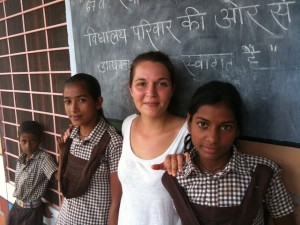Leaving your comfort zone is not easy but Charlotte Havez, a 21-year-old French girl, did exactly that last summer when she volunteered in two Indian schools.
She decided to be part of the Tilak Bal Gurukul program that helps the poorest and loneliest families from Rajasthan, north-west of India, to get the chance to send their children to school. Most of the families come from the lowest casts in India or the Meena tribe.
“Poverty there isn’t what we expect: they all live in secure houses, eat and sometimes even get TV or air conditioners,” Havez said. “But houses don’t get insolation for the pretty cold winter and food isn’t balanced at all. Lots of people get sick and we noticed that many children lost a parent because of that.”
The program is part of a 1991 French association called “Les Enfants de Pushkar” (LEP, Pushkar’s children), supporting many social programs in the area, in partnership with Sarthak Manav Kurtashram (SMK), an Indian organisation that is curing leprosy and taking care of the elderly everywhere in India.
Havez worked in two schools: Nonpura and Langadiyawas located in a countryside zone near Jaipur, capital of Rajasthan. From year 1 to 8, 176 children can enjoy a free high-standard education, managed by SMK and partly paid by LEP thanks to a sponsorship system. Children are selected on financial and social criteria.
The goal is to create year 9 to 12 so children can get a diploma instead of finishing their studies in government schools, which can be catastrophic with just 10 teachers for 500 children.
Havez’s mission was to evaluate the project and get useful information such as photographs, family status, school grades, children’s taste and personality to write newsletters for LEP and the sponsors.
“We met each child’s family to talk about him or her,” said Havez, “However this short meeting wasn’t enough to get to know a child, too shy to talk in front of the family. It’s more at school that I discovered them.”
Most of the children are the first of their family, sometimes of their whole village, to go to school.
“Parents have always worked in the fields or in building construction so it is common that they let their children miss classes to help them out,” said Havez.
Mixed by casts but also by gender, 15 students per class learn mathematics, English, Hindi, sciences, social sciences and Sanskrit.
“It is usually harder for girls to stay in school because they get married very young,” Havez added. “For example, two little girls were married in each school I worked in. Even if this is tradition in India, it remains a shock for a western girl like me.”
 Havez heard lots of stories, happy ones of hearty families but also tough and impressive ones.
Havez heard lots of stories, happy ones of hearty families but also tough and impressive ones.
“I met Rahul, 16, abandoned by his parents when he was young because of leprosy. He worked until he met the SMK organisation that welcomed him a few years ago. He now is cured, goes to school and can read,” said Havez. “When you see his kindness, you can’t guess what he’s been through.”
But finding such an interesting mission to volunteer with wasn’t easy for Havez. Lots of offers are available for engineers or doctors, but it’s the opposite for such tricky institutions as schools.
“I saw lots of organisations offering “a la carte” humanitarian missions with no skills needed. But I felt like it was a well-organised journey to make yourself feel good about it rather than do useful things for the locals,” Havez said.
In the end this French girl lived out one of the greatest experiences of her young life with the chance to learn from another culture. “After all, the most important thing is your desire to discover.”




